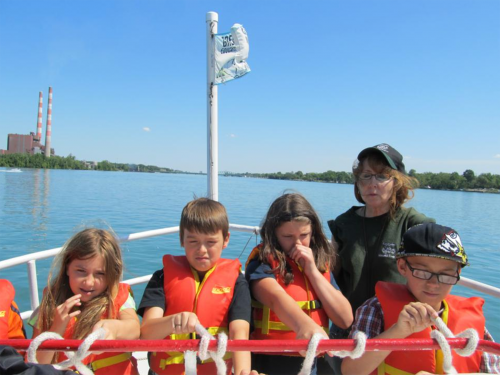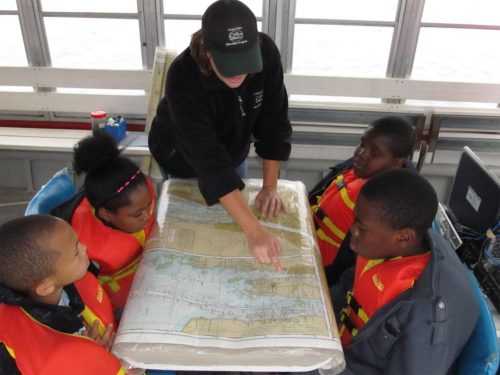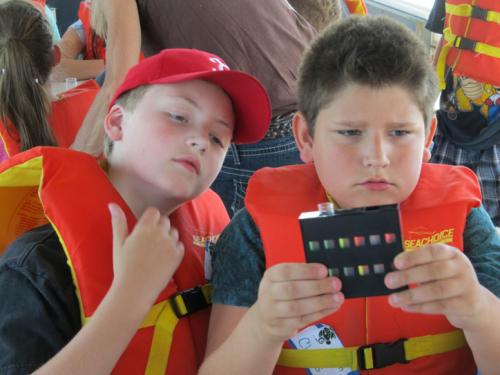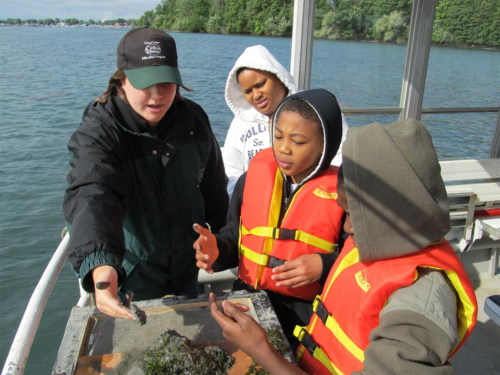Sailing with the Wayne County Great Lakes Education Program
Getting to know the Great Lakes through a shipboard excursion!
The Great Lakes Education Program (GLEP), which is a collaborative effort between Michigan State University Extension and Sea Grant, is preparing to “cast off” the 2013 sailing season. The GLEP is beginning its 23rd year of “school ship” education on both the Detroit River/Lake Erie and Lake St. Clair. The Great Lakes Education Program was recognized as a Program Of Distinction in 2010 by the United States Department of Agriculture (USDA) and the National 4-H Council. This spring’s program begins on April 22 and sails through June 14.
collaborative effort between Michigan State University Extension and Sea Grant, is preparing to “cast off” the 2013 sailing season. The GLEP is beginning its 23rd year of “school ship” education on both the Detroit River/Lake Erie and Lake St. Clair. The Great Lakes Education Program was recognized as a Program Of Distinction in 2010 by the United States Department of Agriculture (USDA) and the National 4-H Council. This spring’s program begins on April 22 and sails through June 14.
 The Wayne County GLEP began in 1998 sailing the lower Detroit River and the mouth of Lake Erie. The area in which the program sails is within the first International Wildlife Refuge in North America. The refuge, which includes islands, coastal wetlands, marshes, shoals and riverfront lands, provides an excellent environment in which to provide a quality educational field experience for students. The International Wildlife Refuge supplies habitat for 29 species of waterfowl, 65 kinds of fish and 300 species of migratory birds in Michigan and Ontario.
The Wayne County GLEP began in 1998 sailing the lower Detroit River and the mouth of Lake Erie. The area in which the program sails is within the first International Wildlife Refuge in North America. The refuge, which includes islands, coastal wetlands, marshes, shoals and riverfront lands, provides an excellent environment in which to provide a quality educational field experience for students. The International Wildlife Refuge supplies habitat for 29 species of waterfowl, 65 kinds of fish and 300 species of migratory birds in Michigan and Ontario.
Since 1998 the Wayne County GLEP has provided 37,958 participants the opportunity to sail with the program which represents 32,520 students, 4,336 adult chaperones and 110 teachers, which represents 1,084 classes from across Wayne County.
The Great Lakes Education Program is divided into the following three components that teachers can use throughout the school year to provide a Great Lakes educational experience for their students:
the following three components that teachers can use throughout the school year to provide a Great Lakes educational experience for their students:
- A classroom introduction to the Great Lakes. Prior to the field trip, students learn about topics such as the aquatic food web, effects of exotic species, wetlands, the water cycle, water chemistry and direct water uses.
- A two-and-a-half hour educational cruise led by staff and trained volunteer instructors on the Clinton River and Lake Saint Clair, or the Detroit River and Lake Erie. Cruises take place on U.S. Coast Guard inspected and certified boats, piloted by Coast Guard licensed captains. GLEP cruises provide an opportunity for hands-on experience with eight learning stations. The stations include bottom sampling, carbon dioxide, dissolved oxygen, marine terminology, marlinspike, navigation/Great Lakes geography, pH, plankton studies, turbidity, water and air temperatures and weather.
- Follow-up activities (classroom and home) and
 discussion. Back in the classroom, students use the field-trip data they have collected to conduct follow-up studies and activities designed to demonstrate learned skills. At home, students have water-related discussions with their families using “My GLEP Cruise” summary materials.
discussion. Back in the classroom, students use the field-trip data they have collected to conduct follow-up studies and activities designed to demonstrate learned skills. At home, students have water-related discussions with their families using “My GLEP Cruise” summary materials.
Impact evaluations have shown GLEP is a highly successful conservation education program. Great Lakes and natural resources knowledge changes significantly due to GLEP participation. Students’ attitudes toward the Great Lakes become more positive, and stewardship intentions are strengthened. Students without outdoor exposure (through boating, fishing on the Great Lakes) experience the greatest gains in stewardship attitudes and intentions. GLEP’s partners, teachers and volunteers are highly satisfied with the program, which has been recognized regionally and nationally.
For additional information regarding the Great Lakes Education Program go to www.glep.us



 Print
Print Email
Email


